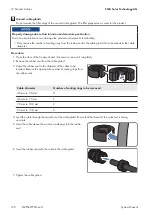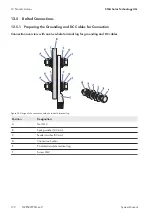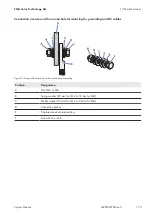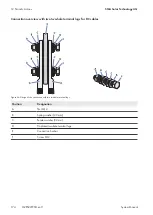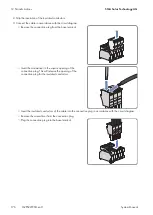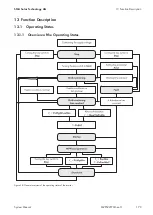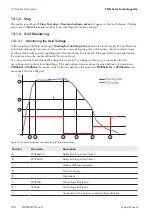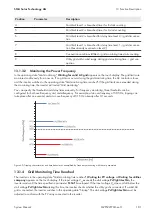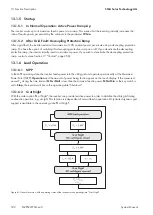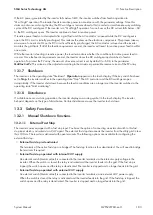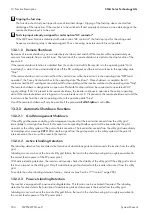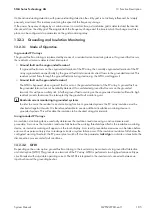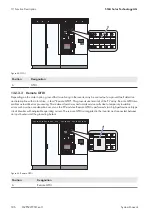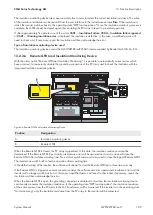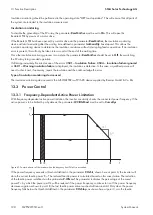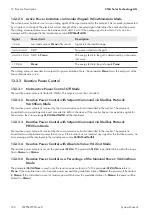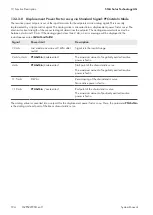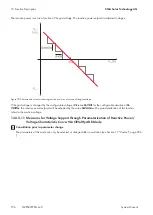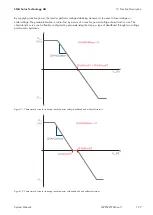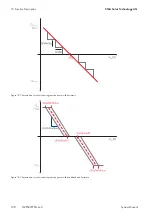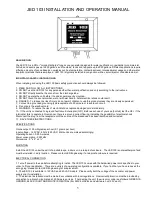
If the AC power generated by the inverter falls below 5 kW, the inverter switches from feed-in operation to
"Q at Night" operation. The inverter feeds in reactive power in accordance with the parameter settings. Since this
status can also occur during the day, the DC switchgear remains closed at first in order to avoid unnecessary switching
cycles of the DC switchgear. If the inverter is in "Q at Night" operation for one hour or the DC current falls below −60
A, the DC switchgear opens. The inverter continues to feed in reactive power.
If reactive power feed-in is interrupted after a grid fault and the AC contactor is opened while the DC switchgear is
open, the DC circuit is initially pre-charged. This reduces the stress on the electronic components. This process takes a
maximum of one minute. Once the DC circuit is sufficiently pre-charged, the AC contactor is closed and the inverter
monitors the grid limits. If all of the feed-in requirements are met, the inverter will revert to reactive power feed-in within
one minute.
While the inverter is feeding in reactive power, the inverter monitors whether the conditions for active power feed-in
are met. Once the feed-in requirements are met, the inverter closes the DC switchgear and switches to feed-in
operation. To protect the PV array, the amount of reverse current is set by default to −60 A in the parameter
QoDInvCurPv
. This value must be adjusted according to the maximum permissible reverse current of the PV array.
13.1.7 Shutdown
The inverter is in the operating state "Shutdown".
Operation
appears on the touch display. If the key switch has been
set to
Stop
, the inverter switches to the operating state "Stop". The AC contactor and the DC switchgear open
automatically. If the inverter shuts down because the feed-in conditions are no longer met, the inverter switches to the
operating state "Grid monitoring".
13.1.8 Disturbance
If a disturbance occurs during operation, the inverter displays a warning symbol in the touch display. The inverter
behavior depends on the type of disturbance. Certain disturbances cause the inverter to shut down.
13.2
Safety Functions
13.2.1 Manual Shutdown Functions
13.2.1.1 External Fast Stop
The inverter comes equipped with a fast stop input. You have the option of connecting an external switch to this fast
stop input which is activated via a 24 V signal. The external fast stop disconnects the inverter from the utility grid in less
than 100 ms. The inverter is delivered with open terminals. The following options are available for configuring the
external fast stop:
•
External fast stop is deactivated
The terminals of the active fast stop are bridged. The fast stop function is thus deactivated. You will need to bridge
the terminals if required.
•
External fast stop operated with internal 24 V supply
An external switch (break contact) is connected to the inverter terminals via the internal supply voltage in the
inverter. When the switch is closed, the relay is activated and the inverter feeds into the grid. If the fast stop is
tripped, the switch opens and the relay is deactivated. The inverter is stopped and no longer feeds into the grid.
•
External fast stop operated with external 24 V supply
An external switch (break contact) is connected to the inverter terminals via an external 24 V power supply.
When the switch is closed, the relay is activated and the inverter feeds into the grid. If the fast stop is tripped, the
switch opens and the relay is deactivated. The inverter is stopped and no longer feeds into the grid.
13 Function Description
SMA Solar Technology AG
System Manual
183
MVPS22JP-SH-en-11
Summary of Contents for 1000-1SC
Page 257: ......


